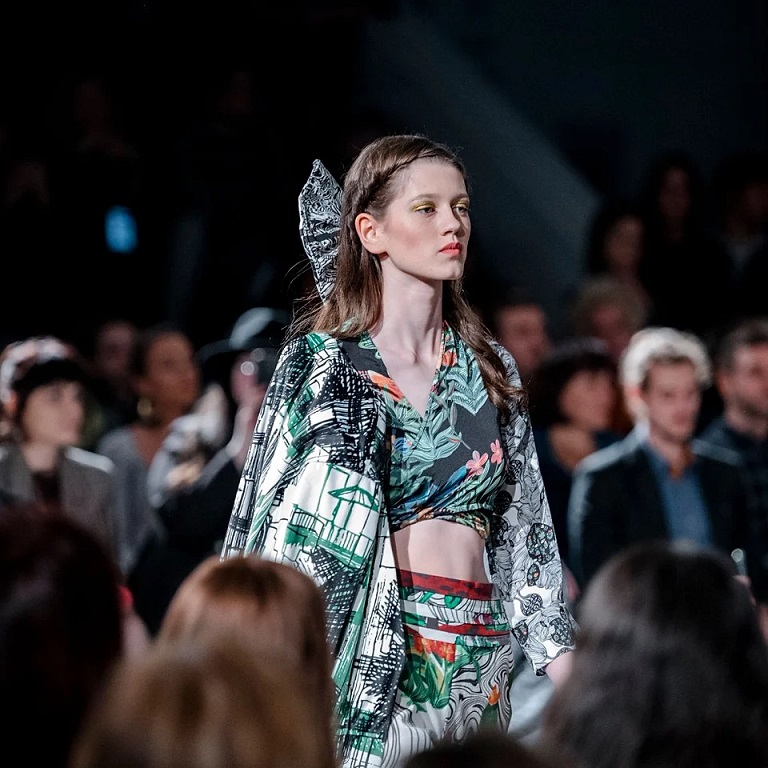In recent years, the world has taken a huge turn, with the pandemic, the energy crisis, and the war in Ukraine all leaving a lasting impact on design fields. As teachers you can follow how all this is reflected in the works of the latest designer generation. What changes and trends did you observe?
Ildikó Kele: The events of the last few years made an obvious impact on the interests, works, and attitude of Fashion and Textile Design students. Their individual orientation, set of values, and world view all greatly influence the direction their design processes will take.
Just like in previous years, sustainability continues to be a key focus for them, along with recycled and biodegradable materials, and circular production processes with a low ecological footprint.
Rapid advances in technology over the past few decades have given rise to unparalleled fashion and textile design solutions and materials. Innovations in smart textiles, interactive clothing, and digital design tools enabled designers to improve the creativity and functionality of their pieces. With classical craftsmanship taking a backseat to accelerating industrial-scale production and electronic and digital technologies, experimentation with traditional techniques in new and unusual ways have come to represent a true challenge and driving force for students.

This generation craves depth and meaning. The proof of their authenticity lies not so much in aesthetics than in the sensitivity and responsiveness of their observations about the world, life and themselves, as well as to building the concept narrative and crafting items. They place great importance on diversity and inclusion, and seek to incorporate various body shapes, cultures, and identities.
The search for identity has always played a crucial role in the lives of this age group, and over the past years there has been a trend for increased focus on personal growth and self-awareness, and emotional journeys, such as trauma and grief processing, in response to ecological and social changes.
Dóra Tomcsányi: In my experience with my own design practice, local brands are gaining more traction and appreciation worldwide. The fashion industry has come under growing pressure as a result of the energy crisis to further embrace sustainability and manage our resources optimally. As teachers we are doing our best to impart this approach to students, to have it ingrained in them as a fundamental design attitude.
What do you think makes the MOME Fashion and Textile Design education so unique?
I. K.: Our training programme fosters a responsible mindset by combining creative processes, research, craftsmanship, and technology. We believe that collaboration and knowledge transfer between different fields can give rise to original ideas, innovative solutions, and positive changes.
Our BA programme trains versatile designers who, in addition to mastering specific competencies, will also gain an understanding of the social, economic, and cultural factors influencing the industry. After completing the introductory Design Solfege course, where all students of the Design Institute work together on smaller or bigger projects, Textile Design students can choose specialisations focused on forming and structure design, such as clothing design, accessory design, woven fabric design, knit fabric design, and print fabric design.
Our MA students have three areas – fashion, textile, and costume design – to deepen their research and technical expertise in and competently and confidently meet the highest professional challenges.
The programme focuses on helping students build a designer identity, sharpen and advance their existing traditional craft and digital technical, and theoretical skills, develop their individual styles through research, experimentation and interoperability across broader professional disciplines.
Students are given the opportunity to regularly visit major international trade fairs such as Heimtextil, Première Vision, and Pitti Filati, as well as build a professional community with their peers across the globe, and meet various international guest teachers at courses, part of scholarships and international projects. They can receive support for the implementation of their diploma projects from members of the faculty, TechPark’s experts, as well as our external professional partners.

D. T.: Much of the feedback received from already graduated students confirm the diversity and high quality of the professional skills mastered at the university. Entering the professional scene (also internationally), they find that they are able to hold their own and gain a competitive edge as a result of completing two specialisations at once, and receiving a highly extensive training during their university years.
We are also trying to keep up-to-date with the accomplishments of our fashion and textile design alumni, and we are always immensely delighted to learn of their successes. I take great pride in having such a large professional community of strong-minded and confident designers both at home and abroad. Whether global brands or emerging artists, MOME graduates are immediately recognisable for the depth, sensitivity, and innovative thinking expressed in their works.
To read the full interview, click HERE!
Source: mome.hu - “This generation craves depth and meaning” – Interview with Ildikó Kele and Dóra Tomcsányi about the MOME Fashion Show, trends, and the future of textile design